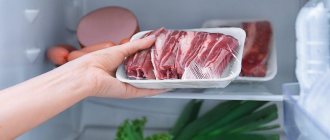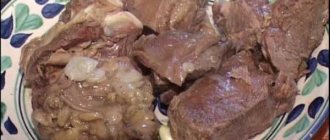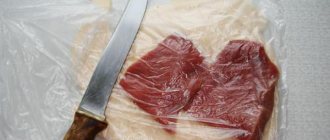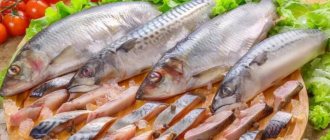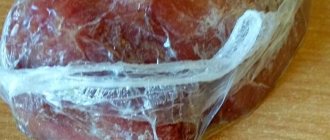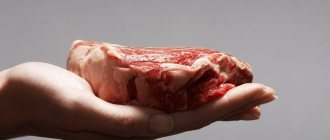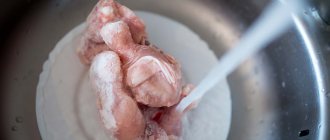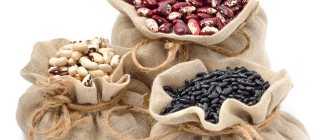This primarily applies to cereals and grains that are prone to absorbing moisture and swelling. Soaking and steeping have many similarities, but professional chefs see a clear difference in culinary procedures.
How to soak roe deer meat?
The meat needs to be soaked in plenty of water for about 8-10 hours. The water needs to be changed 8-10 times. It is better to dissolve vinegar in the last water to create a slightly acidic solution. During the soaking process and under the influence of acetic acid, the meat becomes softer and the smell disappears.
Interesting materials:
How to do the plank exercise correctly for beginners? How to do the plank exercise correctly and how much? How to do morning exercises correctly? How to do visualization correctly? How to do wet cleaning correctly? How to do lunges correctly to pump up your butt? How to do side lunges correctly? How to take measurements for blinds? How to measure a down jacket correctly? How to take measurements correctly?
Smelly product - get rid of it or leave it?
A repulsive unpleasant odor can be due to various reasons. Most often this happens as a result of:
- storage at high air temperatures;
- being near spoiled food;
- storage in cellophane, with a lack of air access;
- improper feeding or pinning of the animal.
If the smell of a product is in doubt, the product should be inspected, paying attention not only to the aroma, but also to the appearance.
The following points should be of concern:
- unnatural color of the product, not typical for a particular type of meat;
- presence of parasites;
- persistent smell of rot and decay;
- uncharacteristic consistency.
If these signs are present, it is better not to use rotten meat for food, but simply throw it away.
But when the smell is not very pleasant, and the product looks normal in appearance, after additional processing it can be used for food. It should be borne in mind that some types of meat, such as lamb, initially have a specific odor, and this does not indicate spoilage of the product.
How to eliminate unpleasant odors at home?
Meat that begins to emit an unpleasant odor should be processed immediately. If there are clearly damaged areas, it is better to cut them off and remove excess fat.
There are two main ways to remove flavor from meat:
- Soak.
- Pickling.
How to remove odor by soaking?
Soaking involves placing the meat in a solution for at least an hour. For this they traditionally use:
- wine;
- a low concentration aqueous solution of vinegar (per liter of water - 1 tbsp.);
- saline solution (per liter of water - 2 tbsp.);
- lemon or pomegranate juice.
The product that requires processing is completely immersed in the solution and left for an hour to several hours. This should be followed by a rinse to remove excess soaking solution.
Pickling
You can marinate meat according to several recipes. For these purposes, spices, salt and other ingredients are used. The simplest option is to rub the pulp with a mixture of salt and sugar. The meat remains in this form for 40-60 minutes, after which it is washed in water. If the smell still does not go away, proceed to preparing the marinade.
Most popular recipes:
- Coat the pulp with mustard and keep in a cool place for 1-2 hours.
- Rub the piece with spices (nutmeg, basil, black pepper, thyme, rosemary, etc.).
- Rub the meat with chopped garlic and chopped onion.
- Aging in soy sauce with added spices.
Using marinating not only eliminates odor, but also makes the product softer and juicier.
Potassium permanganate - Plain English Wikipedia, the free encyclopedia
Potassium permanganate
- an inorganic chemical compound.
Its chemical formula is KMnO 4. It contains potassium and permanganate ions. Manganese is in the +7 oxidation state. It is also known as potassium permanganate
and
Condi crystals
. Potassium permanganate is a strong oxidizing agent, which means it tends to take electrons from other chemicals. It dissolves in water to form purple solutions. If it evaporates, it forms purple-black shiny crystals. [2] It has a sweet taste and no odor. [1]
In 1659, German chemist Johann Rudolf Glauber melted a mixture of the mineral pyrolusite and potassium carbonate to produce a material that, when dissolved in water, became a green solution (potassium manganate). It slowly changed color to purple ( potassium permanganate
), and then finally to red. This report is the first description of the production of potassium permanganate.
Less than 200 years later, a Londoner named Henry Bollmann Condie was a chemist. He was interested in disinfectants and did things like ozonized water
.
He discovered that when he melted pyrolusite with sodium hydroxide and dissolved it in water, the resulting solution had good disinfectant properties. He patented this solution and sold it as Condy's Fluid
.
The problem was that the solution was not very stable. This was fixed by using potassium hydroxide rather than sodium hydroxide. This produced a more stable material. It could also be dried into an equally good potassium permanganate powder. This powder was called Condi crystals
or
Condi powder
. Potassium permanganate was easy to make, so Condie tried to stop other people from making it and selling it himself.
Early photographers used it in powder flash.
Applications in the chemical industry [edit | change source]
Potassium permanganate is used as an oxidizing agent. [3] It is also used in disinfectants and deodorants. It can be used to produce a wide variety of chemicals. In wastewater treatment, it is used to get rid of hydrogen sulfide, a smelly, toxic gas. In analytical chemistry, the exact concentration of KMnO 4 is sometimes used to see how much of a particular reducing agent is present in a titration. In a similar way it is used as a reagent for wood pulp. Mixing potassium permanganate and formaldehyde produces a weak tear gas.
As an oxidizing agent in organic synthesis [edit | change source]
Dilute solutions of KMnO 4 convert alkenes into diols (glycols). This behavior is also used as a qualitative test for the presence of double or triple bonds in a molecule, since the reaction renders the permanganate solution colorless. It is sometimes called Bayer's reagent.
Concentrated solutions oxidize the methyl group of the aromatic ring, such as toluene to benzoic acid.
KMnO 4 oxidizes pseudoephedrine hydrochloride to form methcathinone, a Schedule I drug. Consequently, the DEA has restricted its use and sale by classifying it as a Schedule I controlled precursor. Potassium permanganate is listed as a Schedule I precursor under the United Nations Convention Against Illicit Drugs. trafficking in narcotic drugs and psychotropic substances. [2]
Acids and potassium permanganate [edit | change source]
Concentrated sulfuric acid reacts with potassium permanganate to form manganese(VII) oxide, which can be explosive. [4] [5] [6] This reaction also produces ozone. Ozone can ignite paper soaked in alcohol. This reaction is very dangerous.
6 KMnO 4 + 9 H 2 SO 4 → 6 MnSO 4 + 3 K 2 SO 4 + 9 H 2 O + 5 O 3
Concentrated HCl produces chlorine.
2 KMnO 4 + 16 HCl → 2 MnCl 2 + 2 KCl + 8 H 2 O + 5 Cl 2
The Mn-containing products of redox reactions depend on pH. Acidic permanganate solutions are reduced to the pale pink Mn 2+ ion, as in manganese(II) chloride. In neutral solution, permanganate is reduced to brown manganese(IV) oxide, where Mn is in the +4 oxidation state. Manganese (IV) oxide is a substance that colors the skin when potassium permanganate is applied to it. Potassium permanganate is spontaneously reduced in alkaline solution to green potassium manganate, where manganese is in the +6 oxidation state.
Biomedical use [edit | change source]
- Diluted solutions are used to treat canker sores (0.25%), hand sanitizer (about 1%), and to treat mild pompholyx dermatitis or fungal infections of the hands or feet.
- A dilute solution of acidified potassium permanganate is used in histology to bleach melanin, which darkens tissue details.
- Potassium permanganate can be used to differentiate amyloid AK from other types of amyloid pathologically deposited in body tissues. Incubation of fixed tissue with potassium permanganate will prevent amyloid from staining with AK Congo red while other types of amyloid are unaffected. [7] [8]
Miscellaneous [change | change source]
Dissolved Potassium Permanganate
- Solutions of KMnO 4 were used along with 80% hydrogen peroxide to propel the rocket. In this case it was called Z-Stoff. This gunpowder is still used in torpedoes.
- Dilute (10 mg/L) potassium permanganate can be used to remove snails from plants before adding them to a freshwater aquarium.
- High quality potassium permanganate can be found in pool supply stores and is used in rural areas to remove iron and hydrogen sulfide (rotten egg smell) from well water.
- KMnO 4 is often included in survival kits along with glycerin or a glucose tablet for starting a fire. A glucose tablet can be crushed, mixed with potassium permanganate, and it will light up when rubbed. It can also be mixed with antifreeze from your car to start a fire. This can be dangerous and should be done carefully by dipping some paper in antifreeze and then adding a small amount of potassium permanganate. It can also sterilize water and wounds, so it can be used in a survival kit.
- KMnO 4 is used to treat certain parasitic diseases of fish, to purify drinking water, and also as an antidote for phosphorus poisoning. In Africa it was used as a disinfectant for vegetables such as lettuce.
Solid potassium permanganate is a strong oxidizing agent and should therefore be stored separately from reducing agents. Some reactions require a little water. For example, potassium permanganate and powdered sugar will ignite (but not explode) within seconds of adding a drop of water. Wright Jr., Calkins E., Humphrey R.L. Laboratory research
.
1977
Mar; 36 (3): 274-81. PMID 839739.
Causes of unpleasant pork odor
The first thing a cook might think about is that the purchased meat turned out to be stale or has spoiled due to improper storage. This option is possible, but it is not the only one. Sniff the pieces that have not yet been heat-treated; perhaps there is a “fragrance” from them too, just heating made it more obvious.
It happens that raw meat looks and smells absolutely perfect, and the amber appears only when heated. It does not matter which cooking method is chosen: boiling, frying or baking. In this case, we hasten to disappoint you, the purchased pork is the meat of a knur (boar) - a wild boar that has not undergone the castration procedure. Now you have to solve the problem of how to remove the smell of boar from pork meat to make it edible.
Causes of odor:
- Entire. The hormone testosterone, which is produced by the body of a sexually mature animal, leads to the accumulation in the muscle tissue of a substance called skatole, which is the source of the foul odor.
- Congenital developmental anomalies. It happens that one testicle in a wild boar does not descend into the scrotum and remains inside the abdominal cavity. In addition, as a result of developmental abnormalities, the animal may have three testicles, one of which also remains inside. In this case, after the castration procedure, testosterone continues to be produced, and after slaughter and cooking, the meat will acquire a specific smell.
If you buy boar meat from farmers you know, whether you can eat it without the risk of stinking up the whole apartment during cooking depends on the age of the animal. Buy piglets up to six months without fear, but adult sires should be castrated a couple of months before slaughter.
photo from the site https://animal-photos.ru/
The easiest way to get rid of the smell of boar pork is not to buy such meat. Theoretically, a boar should not even get on the counter, since his meat will not pass certification, but in practice this does not happen so rarely. But how to avoid a mistake, because it cannot be recognized until heat treatment, and even purchasing from conscientious livestock breeders cannot always protect it. To do this, before purchasing, ask the seller to check the selected piece in one of the following ways:
- Light a small piece with a lighter, trust me, you won't be able to miss the pungent amber.
- If the seller does not want to cut off a piece for testing, pierce the pork with a knitting needle or needle heated over a lighter, the effect will be the same. Of course, take sharp objects from home.
photo from ru.wikipedia.org
Other tricks
In order for the meat to be tender and juicy, you need to prevent the juice from leaking out of it during frying. This is best done either by breading or by “sealing” the meat over high heat. Bread the meat immediately before frying. Flour, crackers, eggs or combinations thereof are suitable as breading. Pieces of meat are placed in boiling oil, then the frying process begins immediately, and the meat juice does not leak out.
You can “seal” meat without using breading, and even without using oil. Simply place the meat on a hot frying pan, fry until brownish, turn over and fry in the same way. After this, reduce the heat and fry until cooked over medium or low heat. Beef can even be undercooked - some people like the meat rare. This trick won't work with other types of meat: you don't want to get some Trichinella from a half-cooked pork chop, do you?
An excellent result is obtained if the meat is baked in pots or foil. In these cases, it is cooked in its own juice and turns out excellent even without any additives.
If you are frying cutlets, try to turn them over as carefully as possible so as not to damage them, otherwise the juice will also leak out. And most importantly, do not salt the meat in advance! The salt will draw the juice out of it before cooking. Well, if your roast still turns out a little dry, try fixing the problem with a water bath. Pour water into the pan, place a colander with meat over it and close the entire structure with a lid.
So, if one of your gastronomic experiments has failed, don’t be discouraged, there will always be a way to get it back on track!
This important question has worried housewives from time immemorial. Well-cooked beef has a delicate aroma and high taste. In order for a beef dish to turn out soft and juicy, it is necessary not only to choose a piece of meat, but also to prepare and cook it correctly.
To prepare we will need:
Fresh piece, kefir, onions, kiwi, mineral water, mustard, soy sauce, foil, baking sleeve, stewing pan, kitchen hammer, knife.
1. It is better to marinate the meat before cooking. Pickling options:
A) Spread mustard liberally over the entire piece of meat and let stand for an hour or two. After this, the meat is ready for frying. Before frying, wash the meat to remove mustard. This option is suitable for tough and old beef.
b) Cut the meat into pieces. Perpendicular to the grain! Peel the kiwi and cut into slices. Mix meat with kiwi, marinate for 15 minutes. Do not overcook, otherwise the meat will be too soft. Suitable for medium-tough beef.
c) Prepare a marinade of kefir with spices. Place pieces of beef in it and leave overnight; in the morning the meat can be baked or fried.
D) Soak the beef in mineral water and leave for a couple of hours. This option is suitable for soft to medium tough beef.
Brute physical strength
More precisely, mechanical impact. Wrap a piece of meat in a plastic bag and give it a good pound on both sides with a hammer. After beating, even the oldest meat will become softer and more tender. If chops are not your thing, but you need to put the bad meat somewhere, grind it in a meat grinder. White bread and onions soaked in milk will add tenderness to the minced meat.
Often the meat feels too tough due to membranes and tendons that you forgot to remove during processing. Next time, pay more attention to cleaning the meat and everything will work out. But, of course, that's not all! There are other methods in the world, after all.
Fragrant rabbit
If a rabbit is not slaughtered correctly or has not been fed according to standards, its meat will have a specific odor and taste. There are several methods specifically for this type of meat.
- Soak in cold water for 10-12 hours. If you have time, it is best to do just that, gaining freedom in further use. The meat will be absolutely neutral and ready for any processing method.
- Marinate. For this purpose, you can use kefir, olives with tomatoes, a mixture of wine, sour cream and juniper. The meat will be ready within an hour and will acquire the flavor of the spices and bases used in the marinade.
What is it and why is it needed?
Products are soaked in order to get rid of their undesirable properties. For example, when soaking salted fish (meat), excess salt is removed, eggplants lose their bitterness, game meat (or not too fresh meat with a flavor) gets rid of an unpleasant taste and specific smell. When fresh meat (fish) is soaked, residual blood comes out of the fibers, so the broth during cooking will be more transparent and not cloudy.
Thanks to soaking, toxins are removed from mushrooms, and nitrates from vegetables. As an alternative to soaking, in some cases it is produced. However, you must agree that boiling cannot always replace soaking. For example, if you boil over-salted herring, it will turn from salted fish into boiled fish. It seems that the goal will be achieved, but the end result is completely different.
Potatoes are often soaked to remove excess starch and make the dish less caloric.
As a result of soaking, cereals get rid of the harmful phytic acid contained in them.
Soaking very acidic fruits helps rid them of excess acids, which provoke relapses of gastrointestinal diseases and destroy tooth enamel.
To speed up the process of soaking game meat and corned beef, cooks often add vinegar to the water. When soaked in milk, salted fish not only loses salt, but also becomes more delicate in taste. Sometimes they are soaked in two waters.
What is the difference between soaking and soaking?
If the main purpose of soaking is to change the taste, chemical and aromatic properties of the product, then soaking involves changing the physical properties. For example, in the process of soaking, cereals and grains become softer and swell, as a result of which they boil faster and are then easier to digest. In addition, during soaking, the outer leathery shell of beans, chickpeas, and peas peels off. Here is a detailed article about cooking chickpeas.
When soaked in wheat and buckwheat grains, the natural process of growth of plant hormones and the production of vitamins is launched, so they become more useful. Sometimes wheat is soaked until it germinates (embryos appear), and then the grain is consumed without heat treatment.
Soaking dried mushrooms and dried fruits helps restore their original volume and softens them. If you want it to turn out lighter rather than gray, first soak the mushrooms for 1-2 hours. Then drain the used water and cook the mushrooms in fresh water.
Also, mushrooms and some berries (cherries, cherries) are soaked in salted water to remove worms.
Sometimes soaking allows you to achieve two goals: change the taste of meat and at the same time defrost it.
Disadvantages of soaking and soaking processes
In the process of prolonged soaking, products not only soften and get rid of harmful components, but at the same time they also lose valuable substances, microelements, and natural enzymes.
Remember that soaking corned beef for too long (more than 8 hours) can reduce not only the amount of salt in meat or fish, but also significantly reduce the content of minerals, nitrogenous substances and proteins in them. The pulp, saturated with moisture, becomes watery and its quality deteriorates.
As a result of soaking, vegetables lose not only their bitterness and essential oils, but also some of the vitamins and phytoncides that the body needs for normal functioning. Moreover, vegetables soaked for a long time become tasteless and lose their delicate aroma.
Turkish peas and beans, as mentioned above, are often soaked to remove tough skins. However, not everyone knows that this shell is of great value to the body: it is rich in fiber, which improves the digestion process and intestinal motility.
As you can see, these processes have both advantages and disadvantages. However, the unconditional necessity and benefit often outweigh the negative result. It's up to you to decide what's more important.
How long to soak and soak
To remove bitterness from eggplants, soak them in pieces in salted water for 40 minutes - 1 hour. As a rule, not all. The herring is soaked in water or milk for about 4-6 hours. If the herring is too salty, the water must be changed periodically. The process can be speeded up by cutting the herring lengthwise along the ridge.
Salted meat is soaked for an average of 8 hours. To swell grains and cereals before cooking, it is enough to soak them for 5-7 hours. Dry mushrooms are soaked for softening for 1 hour, dried fruits for 20-30 minutes. To remove worms, fresh mushrooms and berries are soaked in cold water for 1-2 hours. Depending on the type of fresh mushrooms, the content of bitterness, milky juice, and toxins in their pulp, they are soaked from several hours to two days or more. At the same time, add salt to the water and change it periodically. The amount of salt in relation to water is usually taken in a ratio of 1:10.
At the end, I offer a video with advice on how to correct the taste of over-salted herring by soaking:
Whether you're taking a blood-red T-bone steak out of a vacuum-sealed package, unwrapping a lamb like a gift from the paper the butcher wrapped it in, or taking a chicken out of the bag you brought it home in, does the thought of rinsing the meat under running water ever cross your mind? water before cooking?
No need. Don't ever do that. Never rinse raw beef, pork, lamb, chicken, turkey or lamb before cooking it. “But there’s something sticky on it!” you might say. No need. If we could reach across the Internet to slap you on the hand carrying (or any other) underwater, we would. Need more arguments? Fine. In fact, by wanting to clean the meat of bacteria under running water, you are only making the problem worse. This is scientific evidence: Cooks who rinse raw meat before cooking only increase bacterial activity.
Imagine all these microscopic bacteria that are located on a piece of meat. Together with water molecules, they go straight to your mouth or nostrils, settle all over the sink and even on your clothes. Every bacteria that settles on meat as soon as it comes out of the package will die during heat treatment. Unfortunately, the same cannot be said about bacteria that have taken a liking to the sink, dishes, utensils and cutting board - all of this will have to be washed with hot water and soap, then dried and wiped with paper towels before the next contact with meat. If you still have doubts, look at the recipes of any famous chefs: each of them instructs never to wash meat before cooking.
A faithful assistant in the kitchen - a culinary thermometer
To be absolutely sure that dangerous bacteria are burned off in the fire of your frying pan, use a food thermometer. Once the internal temperature of the meat reaches 55 degrees Celsius, you can be sure that nothing inside this delicious piece will threaten your health. For added safety (and flavor), be sure to let the marbled meat rest for at least three minutes before cutting into pieces.
Another argument against: by disturbing the molecular composition formed on the surface of the meat with a stream of water, you complicate the Maillard reaction - a chemical reaction between amino acids and sugar that occurs when heated. In other words, the meat will brown worse when you put it in the frying pan and will lose its unique aroma and taste. The Maillard reaction begins at approximately 110 degrees Celsius. Water, which begins to evaporate at 100 degrees, simply does not allow the meat to heat up enough for the Maillard reaction to begin. This means that a “wet” piece of beef will not begin to brown until all the water has evaporated - and by this time it will already be well-done.
Do not rinse meat before cooking.
So - do not rinse the meat before cooking. In fact, once you've picked it up from the butcher, wrapped in plastic or paper, and unpacked it at home, all you have to do is carefully remove any remaining moisture from its surface with paper towels before putting it in the pan. . And then throw away those towels, and wash your hands thoroughly - for at least 10 seconds under hot water and soap.
Rabbit is famous for its unique taste and dietary properties. Stewed with mushrooms and sour cream or in white wine, it will become a highlight of both festive and everyday dinner tables. But for everything to work out perfectly, you need to know how to properly soak a rabbit carcass.
Not very fresh, long-sitting, suffocated meat: what to cook?
Not quite fresh meat that can still be used for food must be pre-prepared. To do this, it is soaked or pickled.
From recipes, it is preferable to choose those that are prepared with a large number of spices . It can be Caucasian, Indian, Chinese or other cuisine.
A prerequisite for preparing a not very fresh product is high-quality heat treatment.
Molecular weight of potassium permanganate
Molar mass of KMnO4 = 158.033949 g/mol
Convert grams of potassium permanganate to moles or moles of potassium permanganate to grams
Molecular mass calculation: 39.0983 + 54.938049 + 15.9994 * 4
| Element | Symbol | Atomic mass | Number of atoms | Mass percentage |
| Manganese | Mn | 54.938049 | 1 | 34,763% |
| Oxygen | O | 15,9994 | 4 | 40,496% |
| Potassium | TO | 39.0983 | 1 | 24,740% |
In chemistry, formula weight is a quantity calculated by multiplying the atomic weight (in atomic mass units) of each element in a chemical formula by the number of atoms of that element present in the formula, then adding all these products together.
The weight formula is especially useful in determining the relative weights of reactants and products in a chemical reaction. These relative weights calculated from a chemical equation are sometimes called equation weights.
Often on this site they ask to convert grams to moles. To perform this calculation, you must know what substance you are trying to convert. The reason is that the conversion is affected by the molar mass of the substance. This site explains how to find molar mass.
Using a compound's chemical formula and the periodic table of elements, we can add up the atomic weights and calculate the molecular mass of the substance.
If the formula used in calculating molar mass is the molecular formula, the calculated weight formula is the molecular mass. The weight percentage of any atom or group of atoms in a compound can be calculated by dividing the total weight of the atom (or group of atoms) in the formula by the weight of the formula and multiplying by 100.
The atomic weights used on this site are obtained from NIST, the National Institute of Standards and Technology. We use the most common isotopes. Here's how to calculate molar mass (average molecular weight), which is based on isotropically weighted averages. This is not the same as molecular weight, which is the mass of one molecule of well-defined isotopes. For bulk stoichiometric calculations, we usually define the molar mass, which can also be called the standard atomic mass or average atomic mass.
The definition of molar mass begins in units of grams per mole (g/mol). When calculating the molecular weight of a chemical compound, it tells us how many grams are contained in one mole of that substance. The weight of a formula is simply the weight in atomic mass units of all the atoms in the formula.
.
